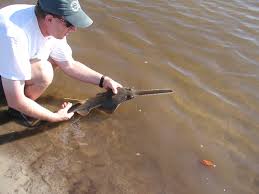As part of her efforts to raise conservation efforts for sawfish since 2001, Wiley will be speaking at next week’s Delicate Balance of Nature lecure series at John Pennekamp Coral Reef Park as well as an Upper Keys center for older adults.
Scientists estimate the smalltooth sawfish population to be around 2,000.
 The peculiar looking smalltooth sawfish has a flattened body with wing-like pectoral fins. It looks like a shark from the back end but appears to morph around its midsection into a ray that partially swallowed a saw — its long, tooth-studded rostrum.
The peculiar looking smalltooth sawfish has a flattened body with wing-like pectoral fins. It looks like a shark from the back end but appears to morph around its midsection into a ray that partially swallowed a saw — its long, tooth-studded rostrum.
Sawfish are part of a group of marine fish in the ray family and have skeletons made out of cartilage. There are found around the world in warm, coastal waters and, in some cases, fresh water rivers and lakes.
Smalltooth sawfish used to be found in waters from Texas to North Carolina, and reported seasonally in the Mid-Atlantic as far north as New York. Today, the species is found almost exclusively in Florida, particularly in the Keys and Everglades National Park, according to Wiley.
Sawfish use their rostrum to find and injure prey. While effective for hunting, it easily becomes entangled in fishing nets.
“Incidental catch of sawfish in fisheries targeting other species is the main cause of severe population declines,” Wiley said. “It’s mainly the shrimp trawlers that encounter the sawfish, and recreational rod and reel. They often get caught in the shrimp trawl net. I understand that the net is their livelihood, so they’ll likely kill the sawfish, but it’s a problem. It’s something we have to figure out how to work around.”
Sawfish “saws” being sold as curios around the world, shark fin soup, overfishing and habitat loss have also led to dramatic reductions in sawfish numbers and range. Degradation of nearshore areas, particularly mangrove habitats, also poses a threat to sawfish recovery.
Another contributing factor to the smalltooth’s demise is their relatively low reproductive rates, much like other rays and the closely related sharks.
Sawfish reach reproductive maturity around 10 years old, or for males when they reach 11 feet in length and for females when they reach about 12 feet in length. Sawfish usually live to 25 or 30 years.
Female smalltooth sawfish remain pregnant for a year and give live birth to seven to 14 pups. Baby sawfish are born with sheaths on their saws to protect their mothers and swim among mangrove prop roots to avoid predators.
“I would say while the population is still endangered, all evidence suggests they are recovering, and a recovering sawfish population in the Florida Keys and Florida Bay is certainly a good sign,” said Florida State University Coastal and Marine lab associate director of research R. Dean Grubbs, Ph.D. “Juvenile sawfish are tied to red mangrove habitats, so having healthy mangroves is critical to their recovery.”
The number of teeth on the sawfish’s rostrum is set during its development and stays the same throughout the life of the sawfish. If damaged, sawfish teeth do not regenerate.
“Smalltooth sawfish have between 22 and 29 on either side and they aren’t always paired, while largetooth species have 44 to 58 teeth,” Wiley said.
While the outlook for the U.S. smalltooth sawfish is better now than when it was initially listed as endangered, scientists estimate a full recovery will take another 40 years or more, provided rebuilding efforts stay on track.
 Wiley and Grubbs are part of a statewide conservation collaborative, the U.S. Sawfish Research and Conservation, which encourages people to respect and release sawfish and report sightings. Scientists have developed safe handling recommendations for both divers and anglers.
Wiley and Grubbs are part of a statewide conservation collaborative, the U.S. Sawfish Research and Conservation, which encourages people to respect and release sawfish and report sightings. Scientists have developed safe handling recommendations for both divers and anglers.
“Even if someone finds a rostrom, we’d want to do a necropsy, so it’s important they report it. Even if you have an old one, we’d like to take a DNA scraping of it. We have kits to send to people who can scrape it themselves and measure it for us. We can get old DNA from those. This information is incredibly helpful,” Wiley said.
Wiley will be presenting her research at 12:30 p.m., Wednesday, Feb. 19, in the J.O.Y. Center at Coral Isles Church, 90001 Overseas Highway; and later that day at 7:30 p.m. in the John Pennekamp Coral Reef State Park visitor center, mile marker 102.5, oceanside.
For more information on sawfish recovery efforts, visit sawfishrecovery.org. Please report sawfish sightings by calling 844-4-SAWFISH.
Source: Scientists continue fight to save sawfish – Keys News
